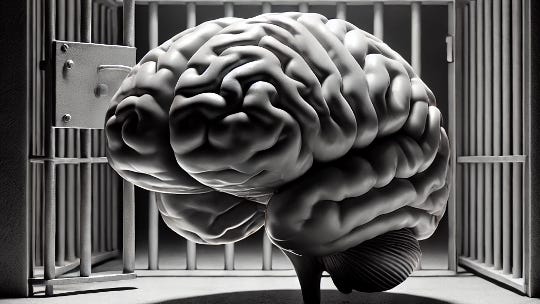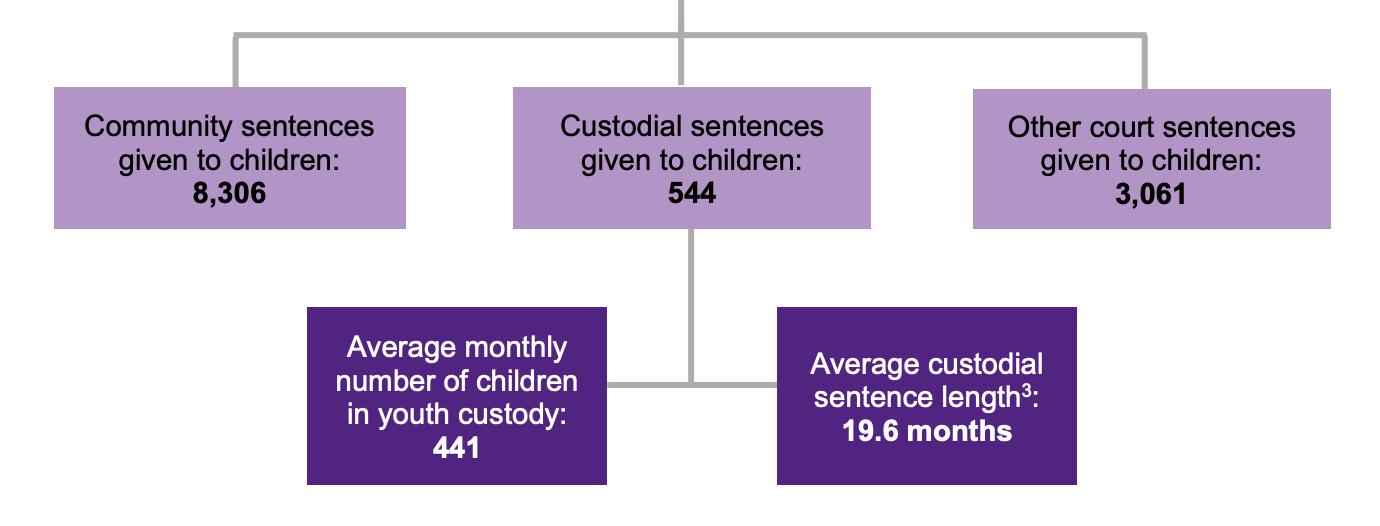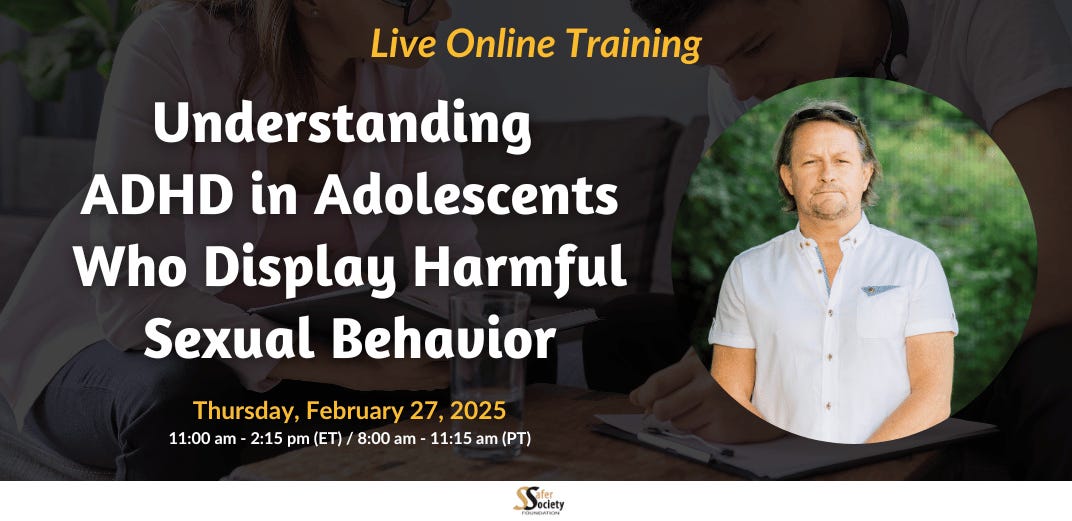The Case for Abolishing Youth Custody (DTOs)
Harmful, Expensive & Criminogenic (Hampson & Day 2025)...
Image © Jonny Matthew 2025 (Made with DALL-E)
If you’re a free subscriber to Jonny’s Substack and would like to support the work please consider becoming as a paying subscriber (it’s only a fiver)…
Introduction
The very first paper to drop into my inbox in 2025 was this one, from Kathy Hampson about why locking up children is a bad idea and needs radical change.
I loved it!
Why It’s Time to Abolish Detention and Training Orders in Youth Justice
When children and young people come into contact with the criminal justice system, the focus should be on rehabilitation, support and creating opportunities for positive change. Yet, in England and Wales, Detention and Training Orders (DTOs) remain a common sentencing option, despite mounting evidence that they are harmful, expensive and largely ineffective in reducing reoffending.
In this post, I’m using Kathy Hampson and Anne-Marie Day’s paper to summarise the harm caused by DTOs, suggest why they should be abolished and to look at how youth justice and other practitioners can advocate for better alternatives.
Firstly, the basics…
What is a Detention and Training Order (DTO)?
DTOs are short custodial sentences given to children aged 12–17. They can last between 4 months and 2 years, with half the sentence served in custody and the other half under supervision in the community.
Introduced as part of the Crime and Disorder Act 1998, DTOs were intended to combine detention with education and training, to prepare young people for reintegration into society.
However, the reality is far removed from this. Research has consistently shown that the educational and rehabilitative provisions during DTOs are inadequate and the custodial experience often exacerbates the difficulties these children faced in the community, rather than resolving them.
The Case Against DTOs
As always, this is not an exhaustive treatment of the subject, but just some thoughts springing from Kathy and Anne-Marie’s paper and more than a few years of working within a very frustrating youth justice legislative framework.
The title of the paper gives away the essence of their argument, namely: that DTOs are ‘harmful, expensive and criminogenic.’
1. A Breach of Children’s Rights
The United Nations Convention on the Rights of the Child (UNCRC - article 37) is clear: detention of children should be used, "only as a measure of last resort and for the shortest appropriate period of time." Despite this, DTOs are frequently handed down for relatively minor offences and many children remanded in custody do not go on to receive a custodial sentence at all. This highlights a clear failure to apply the principle of ‘last resort.’
Indeed, the current sentencing arrangements allow for custody to be a first resort in the youth court, if the offence is serious enough.
Furthermore, children with neurodivergent conditions, special educational needs and those from minority ethnic backgrounds are disproportionately affected by DTOs. While all children should have access to assessment of their capacity to participate in the court process, this rarely happens and, in my experience, is often ridden rough-shod over even when requested by professionals.
The system is not only failing to protect vulnerable children—it’s actively compounding their disadvantages and, at times, flagrantly contravening their rights.
2. The Moral Argument
Children’s brains are still developing, particularly in areas related to decision-making, impulse control and emotional regulation (i.e. ‘top down’ executive functions). This means they are more likely to make poor decisions, or react reflexively without ‘deciding’ anything, without fully understanding the consequences. DTOs fail to account for this developmental reality.
Additionally, many children in the youth justice system have experienced significant trauma, neglect and/or other adverse childhood experiences. Placing these children in punitive environments can deepen their trauma and lead to further behavioural difficulties.
In my view, this is particularly the case where a child has suffered disrupted attachment; to then be cut off from everything familiar can further the damage and significantly limit the hope of rehabilitation, at least while inside.
For girls, the situation seems to be even more concerning. Though they represent only a small percentage of those in custody, the rates of self-harm and use of force against girls in detention are disproportionately high. This, along with the earlier point about attachment, means that DTOs are not just failing—they are actively harming some of society's most vulnerable children.
Source: YJB Stats. p6 - Flows Through the Youth Justice System year ended March 2023
3. Ineffectiveness in Reducing Reoffending
One of the primary goals of the youth justice system is to prevent reoffending. For the first time in 8 years, the overall re-offending rate increased in the last year - though only by 0.9% - to 32.2% (the first time since 2014. YJB Stats. p51)
For custody the picture is bleaker still - much bleaker - at 70.3% for sentences under 12 months and 56.4% for sentences of 12 months to 4 years (UK Post p13). So, overall, children leaving custody have some of the highest reoffending rates of any sentencing outcome, with nearly 60% reoffending within a year of release.
Custody disrupts education, fractures family relationships, isolates children from positive influences and often induces negative-even traumatic-effects. It also exposes them to environments where negative behaviours can be reinforced. In contrast, community sentences have been shown to be far more effective in addressing the root causes of offending and reducing reoffending.
I summary, short term custody doesn’t address reoffending effectively in children - it’s practically useless in terms of rehabilitation and in lots of cases makes the situation worse, not least around the mental health of the kids themselves.
4. The Financial Cost
Youth custody is staggeringly expensive. A place in a Young Offender Institution (YOI) costs around £130,000 per year, while Secure Training Centres (STCs) and Secure Children’s Homes (SCHs) cost significantly more. Despite this immense financial investment, the outcomes remain poor.
Community-based interventions, on the other hand, are not only more cost-effective but also yield better results in terms of reducing reoffending and supporting positive child development.
According to the figures from the MoJ (Hansard) the costs for children and young offenders are considerably higher (brackets mine):
Young Offender Institutions (YOIs): £129,333.58 per year (£354.33 p/day; £2480.37 p/week )
Secure Training Centres (STCs): £305,892.40 per year (£838.06 p/day; £5866.42 p/week)
Secure Children's Homes (SCHs): £299,459.47 per year (£820.43 p/day; £5743.05 p/week)
So neither we (society) or the child and their family are getting any value for money from putting kids in custody - at least not on short sentences. Also, just think what that kind of spend could do to support families in the community if it was routed to services based in the community.
5. A Contradiction of ‘Child First’ Principles
The Youth Justice Board’s ‘Child First’ approach emphasises treating children as children, focusing on strengths, collaborative working, and minimising stigma. DTOs are fundamentally at odds with these principles. They prioritise punishment over rehabilitation and reinforce the very stigma the Child First approach seeks to avoid.
Image © Jurgen Schadeberg 1994
What Are The Alternatives to DTOs
The good news is that effective alternatives already exist. Youth Rehabilitation Orders (YROs), with options such as Intensive Supervision and Surveillance (ISS) or Intensive Fostering, offer robust community-based responses to offending.
These approaches allow children to remain in their communities, maintain family connections, continue their education and receive tailored support from youth justice professionals. Countries like Sweden, Denmark and Japan have shown that it’s possible to reserve custodial sentences for only the most serious offences while prioritising community-based interventions for others.
What Can Youth Justice Practitioners Do?
Youth justice practitioners play a critical role in advocating for change and supporting children within the current system. Here’s what they can do:
Advocate for Legislative Change: Speak up about the harms of DTOs and push for policy reforms that align with ‘Child First’ principles.
Promote Community-Based Interventions: Work with courts and local authorities to champion Youth Rehabilitation Orders and other community alternatives.
Provide Trauma-Informed Support: Recognise the trauma and vulnerabilities many justice-involved children face and ensure interventions are sensitive to these experiences.
Build Strong Relationships: Build trust with children and their families, focusing on strengths rather than deficits.
Collaborate Across Services: Work closely with education, health and social services to provide holistic support.
FINAL THOUGHTS
DTOs are a relic of a punitive youth justice approach that has long been discredited. They fail to respect children’s rights, exacerbate vulnerabilities, cost enormous amounts of money and do very little to reduce reoffending.
By abolishing DTOs and investing in community-based interventions, we can create a system that truly prioritises the welfare, rights and future prospects of children in conflict with the law. For youth justice practitioners, policymakers and advocates, the call to action is clear: it’s time to move beyond DTOs and build a system rooted in care, compassion and effectiveness.
Let’s ensure custody is truly a measure of last resort—not a default response. If I had my way, we'd get rid of it altogether…
See you in the next one!
More information:
PAPER - Kathy Hampson & Anne-Marie Day’s paper: Harmful, Expensive and Criminogenic: The Case for Abolishing Detention and Training Orders in England and Wales (link)
PREVIOUS BLOG - Why Do We Punish When We Could Help l? (Sep.2024 - link)
PREVIOUS BLOG - Youth Justice - A Way Forward (Oct.2024 - link)
WEBPAGE - The UN Convention on the Rights of the Child (link)
PAPER - see UN General Comment 10 (link)
WEBPAGE - DTO Case Management Guidance (link)
WEBPAGE - Youth Justice Statistics for England & Wales 2022-23 (link)
WEBPAGE - UK Parliament Post: The use of short prison sentences in England and Wales (link)
WEBPAGE - Parliamentary question and answer about the costs of youth custody (link)
Subscribe & Follow?
You can join Jonny’s mailing list here. Your information is safe and you can unsubscribe anytime very easily.
If you want these posts sent straight to your inbox, click the blue subscribe button below.
You can also “Like” this site on Facebook or connect with me on LinkedIn or Twitter. The voiceovers are also on YouTube and Spotify. (NB: my Pinterest account was hacked and is now permanently offline).
Really looking forward to this & enjoying the reading & research in preparation. It’ll be online between 4-8pm UK time on Thursday 27th Feb. If you fancy it, register here: https://safersociety.org/understanding-adhd-in-adolescents-who-display-harmful-sexual-behavior/
©️ Jonny Matthew 2025






